Tuol Sleng: S-21 Survivor Testifies
Today, April 18 2016, marked the first day of a new segment: Civil Party and Chum Mey (2-TCW-243) testified in relation to S-21. He told the court about detention conditions and torture that he underwent.
Life before Tuol Sleng
At the beginning of the session, Trial Chamber President Nil Nonn announced that Civil Party 2-TCCP-243 would be heard today in relation to Tuol Sleng. Judge Fenz was absent due to personal reasons and replaced by Judge Karopkin. Witness 2-TCW-865 was on the reserve. All other parties were present with Nuon Chea following the proceedings from the holding cell.
A discussion about a request by the Civil Party Lead Co-Lawyers to admit a book that had been published by the Civil Party (“Survivor”) followed. Judge Lavergne wanted to know why this request was so tardy, whether it was available in all court languages and whether the lawyers requested to admit the book in its entirety or only the excerpt annexed to the request. International Civil Party Lead Co-Lawyer Marie Guiraud explained that the Civil Party’s testimony had only been confirmed on April 4 2016, that it was available in all languages and that they requested only the excerpts to be admitted. The Co-Prosecutors supported the request. Senior Assistant Prosecutor Vincent de Wilde pointed out that the French translation was very poor and that they would quote in English if needed. Nuon Chea Defense Counsel Victor Koppe stated that they did not have any problem with this document being admitted. However, he pointed out that they hoped to receive the same leniency when a tardy request was made by the Nuon Chea Defense Team the next time. The Khieu Samphan Defense Team had no objection either. After briefly conferring with the bench, the President announced that the document was admitted. Reasons will be filed later.
The testimony of the Civil Party then commenced. Civil Party Chum Mey alias Mei was born in L’vea Commune Prey Veng Province in 1933. He now lives in Phnom Penh. He sells books about his background and experience at Tuol Sleng museum. His four children and wife all deceased during the Khmer Rouge regime. He had been interviewed for Case 001. He was arrested in September 1978.
The floor was given to Civil Party Lead Co-Lawyers. Pich Ang handed over to lawyer Hong Kim Suon. He asked where Mr. Mey lived before April 1975. Mr. Mey replied that he lived in Chbar Mon in Kampong Speu Province. He was with Prince Chang Raingsey. Then he went to Phnom Penh, where he lived with a doctor called Louk Lean. Before 17 April 1975, he lived in Kampong Speu in Chbar Mon with Prince Chang Raingsey, after which he lived with Louk Lean. He was a mechanic. He repaired tractors and vehicles. A few days before 17 April, he stopped working as a mechanic, “because Phnom Penh was in a chaotic situation” and they could not work anymore. There were artilleries and shells falling into the city at that time. The artillery came from the Khmer Rouge soldiers, he said.
Mr. Kim Suon then wanted to know what Phnom Penh “was like” on 17 April 1975. Mr. Mey replied that the city was “heavily damaged because of the bombing’. Schools and hospitals were burned and damaged. He saw the arrival of the Khmer Rouge into the city. At this point, Khieu Samphan
Defense Counsel Anta Guissé interjected and said that the segment was not related to the evacuation of Phnom Penh and that the questions seemed to be off-topic. Mr. Kim Suon replied that he was asking about the harm and suffering that he may have experienced even before 17 April 1975. The President allowed these questions, but said that they were not supposed to be the focus of the questions.
Mr. Kim Suon asked whether the Civil Party received any instructions to leave the city by the Khmer Rouge when leaving Phnom Penh. Mr. Mey replied that he was evacuated twice: once in 1975 and the second time on 7 January. During the first evacuation, people in Phnom Penh were forced to leave the city. The people in black uniforms said that there would be American bombings. They walked about 33 kilometers to Prey Kdam, where they arrived at night time. His child had fever and died. He buried his child before continuing their journey.
They returned to Phnom Penh to repair vehicles after spending around 30 days outside the city. They were assigned to repair boats and ferries. They worked there for around three months before being transferred to Orussei. He did not know which specific unit they belonged to there. They were assigned to collect sewing machines so that they could be repaired. The unit was called the sewing unit. The supervisor was called Kun. He repaired the sewing machines and trained about twenty other repairers. He knew Khieu Samphan at Orussei, because “the kitchen staff told me”. He came with two men and wore a scarf around his neck. Khieu Samphan came to inspect the “cooker that I made”. The cookers were used to cook in the unit at Orussei. The rice was cooked in packages and distributed to people who were evacuated from Svay Rieng at the railway station in Phnom Penh. He did not dare to approach or talk to Khieu Samphan. Mr. Mey did not know whether he talked to anyone. Later, a woman in the kitchen hall told him that this person was Khieu Samphan. He worked in this unit until 29 October, when he was asked to go to Vietnam to repair vehicles. However, he was transferred to Tuol Sleng instead and not to Vietnam.
He attended small meetings in the tailor unit about the “livelihood meetings”. He also attended a collective marriage of around twenty couples. He was asked to attend the marriage. Supervisor Kun was taken away and replaced by Chhun, who in turn was replaced by Yong, who was replaced by someone from Takeo.
Arrival at Tuol Sleng
He was asked to board a pick-up truck and wanted to bring along some repairing tools with him. He was told that the repairing tools would be sent later on. When leaving Orussei, they reached a pagoda that was located near the stadium. When they arrived there, they turned to the east to the Chinese Hospital. They then turned south to the electricity station before reaching Tuol Sleng. All three detainees were handcuffed and blindfolded when getting off the truck. The people who guarded them were male, including a person called Lin. They were armed.
They pulled his ear to walk across the road “and they kicked me on my waist”. Thus, he fell down. He was sent to a cell in which he was only allowed to wear shorts. His hands were tied behind his back and he was sent to Room 022. He could not look around what was outside. The room was very dark.
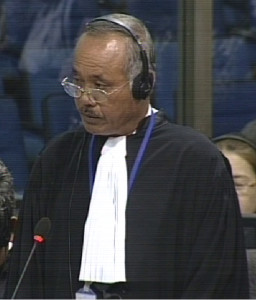
Civil Party Lawyer Hong Kim Suon
He was pushed into Room 022. After sitting down, his ankle was shackled. When he was shackled, his hands were released. After this, he was not blindfolded anymore, but bags were used to block the window. The room was 1.5 times 2 meters, he recounted. The Co-Investigating Judges had asked him whether this was the room where he was detained.
Mr. Kim Suon wanted to show the Civil Party a photograph of the room, but since the other parties did not have the book in front of them, he moved on. There was only one person detained in that room. It “could not accommodate two persons”.
There was a small bullet container in which he should relieve himself. He was told that he had relieve himself in the cell. If he spilled anything, he would be required to lick the spillover on the floor. He was told not to talk to other people adjacent to his cell, but was required to be quiet. On the first day he was given a ladle of watery gruel in the morning and the evening. Only later he was given water. He was beaten for twelve days from 7 am until 11 and from 1 until 5 pm, and then form 6 pm until 10 pm.
Mr. Ang asked the court officers to deliver the page with the picture of the cell to the other parties. There had been an e-mail by Eleonor Fernandez on April 11 2016 and was on the g-drive.[1] The President announced that it was time for a break.
Interrogations and living conditions
After the break, the floor was granted back to the civil party lawyers. Mr. Kim Suon inquired about the interrogations. The Civil Party recounted that he was interrogated for twelve days, during which he was tortured and asked whether he was KTB or CIA agent. He had replied that he did not know what that had been. They broke his finger and took out his toe nails. They hit him and put electric shocks on him. As a result, he lost consciousness. He was electrocuted twice. One of his eyes cannot see things well, and one of his ears cannot hear well since that time.
Asked about reasons for his torture, he said that: “During the twelve days and twelve nights of torture, I thought about the possibility that someone may have implicated me. That’s why I was arrested and sent to the prison.” They continuously questioned him about CIA and KTB agents. He fabricated names and did not implicate anyone, he said. He did not know whether the names that he fabricated belonged to existing people at the time. After he confessed, the interrogators said that “you would have not been beaten if you had given the confession earlier”. He was not beaten again after this. They did not read out his confession to him. They required him to put his thumbprint onto the confession. The detention room was in building C on the top floor. His hands were shackled along with other detainees. There were also building A and B. Building C was within the compound of Tuol Sleng. There were around forty detainees in the room. They were all shackled at their legs. They were “no longer given the watery gruel. Instead, we were given gruel and we were given long sleeve clothes”. They were given enough water to drink. They were given a ladle of gruel in the morning and the evening. They were required to sleep on the floor and had neither mosquito nets nor sleeping mats.
Surviving
A person had asked whether anyone knew how to repair the sewing machines. If yes, they would bring clothes to sew. The place was located in the back to the west of the building where he was detained. He did not dare to look outside. There was only one detainee in his room.
Mr. Kim Suon wanted to know whether there was a punishment for spilling on the floor when relieving themselves. Mr. Mey replied that they were required to lick the spillovers, whether they had defecated or urinated. They had to lick it with their tongue until it was clean.
He was assigned to repair the sewing machines first and later the typewriters. He repaired three typewriters. After this, he was assigned to repair the water pump.
He said that he was able to survive, because he was the only one who was able to repair the typewriters. Moreover, there were bombings to the east later and the situation in the prison became chaotic. When the (Vietnamese) front army arrived, they did not go straight to Tuol Sleng, but went to Psar Thmey first. At this point, the guards at Tuol Sleng gathered all the prisoners and walked them out of the prison. This was on January 7 1979. “Without 7 January 1979, I would not survive. I would die and there would be no time for today that I see all of you in the court room. I suffered a lot. My family members were killed and only two of my siblings survived. The others were all killed.”
When Mr. Kim Suon asked about the harm and suffering the Civil Party had experienced, an discussion about the appropriateness of asking this question now emerged, at the end of which the President instructed the Civil Party lawyer not to ask this question now, since the Civil Party would be given opportunity to express his harm and suffering at the end of the testimony.
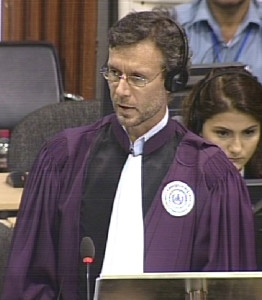
Senior Assistant Prosecutor Vincent de Wilde
Only Bou Meng and he were still alive today of the people who had survived Tuol Sleng. He could remember two leaders of S-21.
The floor was then granted to the Co-Prosecution. Senior Assistant Prosecutor Vincent de Wilde asked whether he knew why Khieu Samphan came to visit the clothes-making unit. Mr. Mey said that he did not know at the time. He did not know Khieu Samphan’s position. There were two guards walking behind the individual. Yong and Kun were chairmen at the location.
Mr. de Wilde then wanted to know who brought him to Tuol Sleng. He answered that there was a female comrade whose name he could not remember. There was another individual who was called Lin, who took him there.
There were three other people taken to Tuol Sleng. Lin had just arrived and brought him to Tuol Sleng two days later. When he asked someone to take care of his wife and children, he was kicked and the person said “you motherfucker, why are you asking me to take care of your wife and children”. They said that they would smash all of us who would be considered traitors.[2] “It was a misery back then for me, I did not know what my fate would be”. His wife was pregnant when he was arrested. He was concerned for her, since he “did not know whether she survived after I left”.
Back to living conditions and interrogations
Mr. de Wilde then inquired whether the initial questions that were asked before they took his photo were related only to his name and place of birth, or also about class and occupations that he had held. He replied that he told them lies when he fabricated names.
Mr. de Wilde requested leave to present photos of the re-enactment of the facts of Tuol Sleng.[3] The request was granted and Mr. de Wilde showed two photos.[4] When presented first photo that showed a cell, he replied that his cell number was 022. There was no sunlight coming into the cell in contrast to the photo.
He had no strength and energy during the 12 days that he was interrogated due to a lack of food and since he had to sleep directly on the floor. Mr. de Wilde wanted to know how he was able to wash himself when always being shackled and wearing shorts. He replied that he was detained for four months and twelve days and was washed once by them. He was asked to strip off his shorts when they brought a water bucket to his room. He could not take it off, since one of his legs was shackled. He was asked to try to remove the shackle. At this time, he received some lashes, since he was not able to remove his ankles out of the shackles. Mr. de Wilde wanted to know whether this experience was humiliating for him. He replied that he was concerned that he was killed and was fearful. He was afraid he would die one day. He was considered a traitor at the time and “regarded as an animal”. In terms of his right to speak and eat, “I had no freedom”.
Mr. de Wilde inquired whether the interrogator explained to him what CIA and KTB could mean when questioning him. He replied that this was not the case. “Later on, they wanted to find out about CIA and KTB” and he learned that CIA were spies for America and KTB for Russia.
He did not who the supervisors were. He knew that Kaing Guek Eav was the chief of the prison and that Hor beat him. The first individual who beat him was Sieng. Two or three days later, Tit appeared at the location. Later, Tit told Hor that he did not confess. After this time, Hor picked up a stick to beat him and insulted him. Hor said “you motherfucker, why did you not confess”. There were no medics at S-21.
He confirmed that Sieng sat on his head and used the stick to hit his kneecaps. The Civil Party explained that it was very humiliating in Khmer culture to sit on someone’s head. Two of his toe nails that had been pulled out came back, but “did not look very nice’. They poured alcohol on his toe and did not apply any medicine on him. He did not dare to “shout out loud, because I was afraid that I would be beaten. So I bore the pain by closing my eyes”. When asked whether being electrocuted or having the toenails pulled out was more painful, he said that being electrocuted was very painful and that he fell unconscious then.
“At the time, I suffered severely. I thought that if I survived, I would tell the world about this pain and suffering”. At this point, the President adjourned the hearing for a break.
Leaders
Before giving the floor to the Co-Prosecution after the break, the President informed the parties about two issues. First, the testimony of 2-TCW-865 could not be heard after the end of Chum Mey today, since they were still waiting for the report by WESU. The Chamber would inform parties about the date of the hearing of the witness. Tomorrow, 2-TCW- would be heard.
Second, the Chamber had received an e-mail by the Nuon Chea Defense Team to admit eight documents for the testimony of 2-TCW-919, as well as the manuscript of the book that the witness had written.
The floor was granted to the Co-Prosecutors. Mr. de Wilde wanted to know whether he had ever met Nuon Chea. He replied that he attended a meeting. Nuon Chea announced that anyone who had still attachments to the old regime could announce that during the meeting and Angkar would forgive them. He attended the meeting with the garment workers, but could not recall when this meeting took place. He repaired boats at Russei Keo. When he attended the meeting, he already worked at the tailor unit called K-9. He explained that people “raised their hands to declare that they were not related to the imperialists”. Nuon Chea said that any comrades who were not detached from imperialists yet could make a declaration to Angkar and Angkar would forgive them. After they left the meeting, each of them went back to their respective unit.
He confessed, because he was forced to do so. His finger was broken when he used his hand to protect himself from being beaten. The second day, his toenails were taken out. On his third day, he was electrocuted and lost consciousness. Since then, one of his eyes cannot see anything anymore.
Confessions
When asked about the truthfulness of his confession, he said that parts of it were true, while other parts “were not real”. He had indicated of having been part of the CIA, which he told them “according to their wish”. Mr. de Wilde read out an answer of his Written Record of Interview.[5] The Civil Party replied that he fabricated information when his suffering was too high. “In fact, I had no knowledge at all of CIA and KTB”. Mr. de Wilde wanted to know whether he re-read his confessions after 1979 and whether this corresponded to what he had said or whether the interrogator added some facts.[6] Mr. Mey replied that he did not read the document. “Because after I left the prison, I did not have the feeling to read or look at any document”, he explained.
Mr. de Wilde referred to a list of 68 names that were noted at the end of Mr. Mey’s confession.[7] He had mentioned the names Kun, Chhun, Yong and Mr. de Wilde wanted to know whether he had made up these names or gave the real names. Mr. Mey replied that these people had already been arrested, which was why he had given their real names.
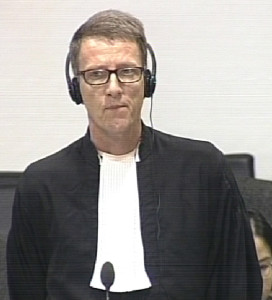
International Nuon Chea Defense Counsel Victor Koppe
When Mr. de Wilde wanted to know whether he knew the number 68 – Pang, secretary of Ministry 871 – or whether this name had been added by interrogators, Mr. Koppe interjected and said that, albeit he did not object, the prosecutor was reading from a confession. He sought guidance in relation to what was allowed to ask with regards to this confession. Judge Lavergne said that parties should clarify the reasons for using confessions before asking questions: was it to verify the truth of a confession or rather for other reasons that had already been authorized? Mr. de Wilde explained that the purpose of the question was to see whether interrogators were at liberty of adding names.
After conferring with the bench for a few minutes, the President announced that the question was allowed, since it did not aim at verifying the veracity of the confession. The Civil Party recounted that Pang told him not to use the expensive bricks to build the cooker. He was told by someone in the kitchen that his name was Pang, but did not see him anymore afterwards.
He felt like he “was born again after 1979”. Mr. de Wilde read out an excerpt of Duch’s statement, who had said that Hor had decided to take Chum Mey as a mechanic and that the execution could be delayed by this. Duch had said that Hor talked to him not to escape.[8] Mr. Mey replied that he was brought to the workshop at the back and told not to escape. His hands were released from the strings so that he could fix the sewing machine. He was told by Van Nath that there were Vietnamese and Cham prisoners.
Turning to his last line of question, Mr. de Wilde inquired about the fate of his family. Mr. Mey recounted that his son died at Prey Kdam. His two daughters were with his wife there. When working at Orussei, he sought permission for his wife to work as a tailor. His oldest daughter knew how to sew. His other daughter was elsewhere. When he was arrested, his wife and daughter did not know that he had been sent there.
Mr. de Wilde inquired whether he had not ever “been able to detach yourself” from the memories of S-21 or whether he felt obligated to go to S-21 until now. He replied that he “no nation in the world killed their own people”, and that he could not forget the suffering. “So I cannot forget the regime. Now I am selling books. I am telling the stories to tourists. […] I consider myself as a psychotic person.” He wanted to tell people about torture that was inflicted upon them.
Clarifications
The floor was granted to the Nuon Chea Defense Team. Mr. Koppe wanted to know whether it was correct that he was born on 9 November 1933. The Civil Party confirmed this. Mr. Koppe asked whether he was born in L’vea subdistrict, Preah Sdech district in Prey Veng Province.[9] He replied that the name was changed later. He had six brothers and two sisters.
Mr. Koppe then wanted to know what his connection was to Prince Chang Raingsey. He replied that Prince Chang Raingsey was living in the area. He was told that he held the rank of brigade general. He denied having stayed in the same house. He went there to repair vehicles for him. This prompted Mr. Koppe to refer to his statement, in which he had said that he worked in the public affairs office of Prince Chang Raingsey’s before being taken to Damnak Samnang, where he stayed in Raingsey’s house, waiting for orders.[10] Mr. Mey recounted that the prince had him picked up by helicopter to go to another place. Mr. Koppe asked what he had meant with “await his orders”, since this, according to Mr. Koppe, seemed to imply that he was a military. Mr. Mey replied that he was not a soldier and only repaired vehicles. He denied having received orders. He was instructed to stay at the home waiting for peace.
Mr. Koppe wanted to know when he got to know Ung Pech. He replied that this person was also a mechanic. They worked together during the Lon Nol regime. He confirmed having fled at the same time. He also confirmed that Ung Pech waved at him at S-21. However, they did not talk to each other. He was too afraid to talk to him at S-21. They escaped together and they were walked at gunpoint. When they reached Ang Snuol, he met his wife and family. “I asked them for permission that I could carry my child and they allowed me to carry my child.” He gave a scarf to a woman who delivered a baby. When the Vietnamese soldiers fired to disperse people, “I was separated from other … travelers”. Mr. Koppe referred to his testimony in front of the court, in which he had said that they opened fire on them and that Ta Eng was shot at that time.[11] Mr. Koppe asked whether Ta Eng was Ung Pech. Mr. Mey said that this was another person who was brought to Tuol Sleng from Kampong Cham. Ung Pech travelled elsewhere. They were required to sleep in a pagoda. At 10 pm, all Khmer Rouge soldiers disappeared and only one watched them. Later, three Khmer Rouge soldiers arrived and asked where the three people were who needed to be killed. Eng was also at S-21.
He did not know whether Ung Pech gave evidence to the tribunal that tried Pol Pot and Ieng Sary in 1979. Mr. Koppe asked whether he knew who Lep Chan was.[12] The Civil Party did not recognize this name. Nor had he heard of the name Ruy Nea Kung. Mr. Koppe read an excerpt of Ung Pech’s statement in the 1979 trials of 25 June 1979, in which he had said that there were four survivors of S-21: Ung Pech, Lep Chan, Nath, and Rui Na Kong (Ruy Nea Kung). Mr. Koppe wanted to know whether he had an explanation why Ung Pech did not mention his name as a survivor of S-21, despite knowing him well. At this point, Mr. de Wilde objected and said that the person talked about four survivors, but that he was separated from others. Mr. Koppe responded that the Civil Party should give a reaction as to why his name was missing. The objection was overruled. The Civil Party said “I have no reaction to this question”. They were separated from each other at Ang Snuol. Ung Pech counted the four survivors based on those who came from Ang Snuol to the city with him.
Doubts about truthfulness of Civil Party
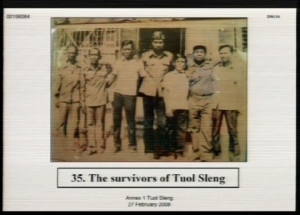
S-21 survivors
After the break, Mr. Koppe wanted to know whether the Civil Party attended the 1979 trials as a visitor. He answered that he only participated in the second trial. He did not attend the trial in which Ieng Sary and Pol Pot were tried in absentia. Mr. Koppe inquired whether he ever found out why Ung Pech was called to testify as a witness, while Mr. Mey was not. Mr. Mey said that he was working at public affairs at the time. Mr. Koppe referred to a document.[13] The Civil Party had participated in the reconstruction of S-12. The Co-Investigating Judges had said Mr. Mey told them that that the photograph had been taken by a German photographer in 1981 in front of building C and had identified seven Tuol Sleng survivors.[14] Mr. Kope asked the Civil Party to identify the seven people on the photo again, which Mr. Mey did.
Mr. Koppe requested leave to present four stills of the German documentary Die Angkar.[15] The first video still showed two people, the left one of which was the Civil Party and the right one carpenter Rui Kong. Mr. Mey said that the photo was taken when they were younger and that he could therefore not identify them well. Mr. Koppe asked whether he remembered an East-German camera crew coming to Tuol Sleng in 1981. He answered that he did not know when the film was shot. The photo of the seven people was shot by someone from Berlin.
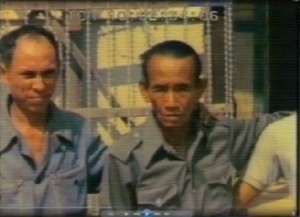
Video still: S-21 survivors Chum Mey and Rui Kong
The East German took photos of skulls and showed them to the UN, but they did not believe him. Thus, the photographer returned to Phnom Penh and took photos of the survivors. He returned to the UN, who started to believe that mass killing had taken place. He told the investigators that he had not participated in the camera shootings, but Ung Pech had told him to come and have a photo shooting. When asked whether he remembered interviews with the East German filmmakers, he said that he did not remember clearly. When Mr. Koppe asked whether he knew why the filmmakers never asked him for an interview, Mr. de Wilde objected and said that the question invited for speculation. Mr. Koppe replied that he was not asking for speculation, since four others were asked about their experience while Mr. Mey was not. The objection was overruled. Mr. Mey answered that he could not tell the court about the colored photos, since they looked different to the ones in the black and white photo. The Civil Party said that he did not participate in the shooting. As for the colored photos, he almost did not recognize the people in the photos, since they looked younger than the people he recognized. He also had problems with his eyes, which was why he could not see things clearly.
As for the film, he replied that he participated, but that the camera crew did not ask him about the story. Ung Pech had told him to go back to work afterwards. He replied that he had been invited to participate in film-makings many times.
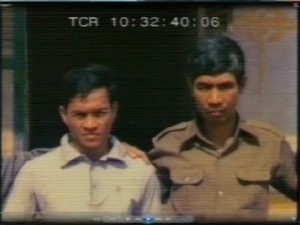
Video still: the Civil Party did not give a definite answer on the identity of these two persons
Mr. Koppe then inquired whether he knew why there was no photo that resembled Mr. Mey at S-21. At this point, Mr. de Wilde objected and said that it was speculative. He answered that he was wearing the number when the photo was taken. He met the photographer Nhem Ein why his photo was not there, but the photographer could not tell him. He told him that the photos might have been burned along with others.
Mr. Koppe wanted to know whether he had told him his right birth date. He replied that he had told them about the region where he was from. Mr. Koppe inquired whether he had told the interrogators that he was 47 years old. He now corrected him and said that he was 48 years old when he was arrested. Mr. Koppe said that if he was born in November 1933, he would have been 44 when he was arrested. After a discussion with the President, the Civil Party said that he was old now and could not remember well.
Mr. Koppe referred to the new OCIJ S-21 prisoners list. He sought leave to ask the Civil Party about numbers 665 9337, 9431, and 10561.[16] These numbers corresponded to Chea Hut; Sun Dim, Net Phan alias Nuon (9432), Chin Sok and Bun Nheng.
Mr. Mey said that he did not know these names. The national lawyer for Nuon Chea read out the names again. The Civil Party said that he still did not know. Mr. Koppe said that these people were arrested around the same time or even the same day as Chun Mey and worked at K-09, “which supposedly is you”. The Civil Party replied that thousands of people were working there. Mr. Koppe asked about Chea Hut specifically, who was chief of the Iron Unit in K-09. The Civil Party could not remember this name. The Civil Party said that he was not told the names of all the people who were arrested.
The President adjourned the hearing. It will continue tomorrow at 9 am with the testimony of witness 2-TCW-919.
[1] Page 50 (KH), page 38 (FR and EN).
[2] E3/7451, at 9:25.
[3] E3/9431, 45 and 46. Annex 1 to Written Record of Interview of Re-Enactment.
[4] 00198074 and 00198076.
[5] E3/5153, at p. 2.
[6] E3/9253.
[7] E3/9253, p. 21 and 23 (FR), 22-24 (EN), 00170580-85 (KH).
[8] E3/770, at p. 2 and 3.
[9] At 00156834 (EN), 00152375 (KH), 00351286 (FR).
[10] E3/5885, at 00152377 (KH), 00156836 (EN), 00351290 (FR).
[11] E3/7451, at 09:46.
[12] E3/2144, at 00190231 (EN).
[13] E3/5765, at 00198003 (EN), paragraph 8.2.
[14] E3/9341, at 00198064 (EN).
[15] E3/3095R, documentary Die Angkar.
[16] E3/93.2.
Featured Image: Civil Party Chum Mey (ECCC: Flickr).
